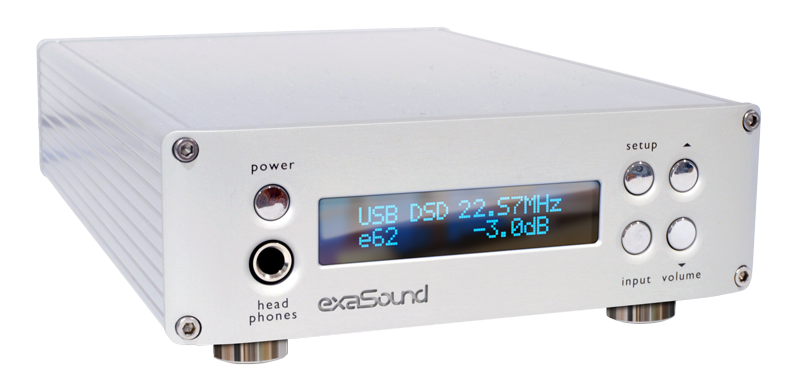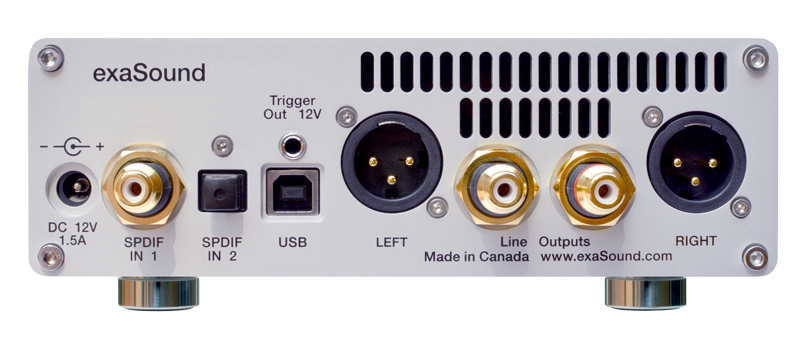exaSound’s e62 DAC brings native DSD512 support to our award winning compact product line. With a truly balanced design, a high power, high performance headphone amplifier and ultimate resolution volume control, the new e62 DAC is designed and manufactured entirely in Canada. Never has affordable digital sounded so true…

The e62 DAC is based on the enhanced ES9028PRO monolithic DAC chip from ESS. Leveraging the world’s highest performance 32-bit Hyperstream technology, the ESS Sabre Pro series enabled us to create the next generation of Reference Class conversion. The e62 will bring out the true resolution power of your audio system.
exaSound’s in–house design delivers world recognized, award winning sonic purity
-
ZeroJitter™ — a unique true asynchronous USB interface with error correction assures accurate data reception
-
ZeroResolutionLoss™ — an exclusive volume control with three–way volume synchronization
-
GalvanicInfinity™ — affords complete galvanic isolation for ultimate external noise reduction
-
FemtoMaster™ — our quad-clock architecture, with 82 femtosecond master clock and 3 auxiliary stream-control clocks, minimizes jitter for maximum timing accuracy, image development and bass extension
- Truly balanced design - yields the best analog noise performance and lowest distortion
e62 is a Roon Tested DAC. It has been profiled and tested by both Roon Labs and exaSound for maximum compatibility with the Roon software and service. Roon identifies exaSound devices and sends them audio optimized for their capabilities. Together, Roon and exaSound deliver the power, flexibility, and performance benefits of digital audio, with the easiest setup and highest reliability available.
MQA (Master Quality Authenticated) is a new technology which delivers studio master quality audio using no more bandwidth than a CD quality file – so it can be easily streamed or downloaded. MQA encoded content is available from major streaming services and download sites.
Streaming Options






The exaSound
Sigma Streamer turns any exaSound DAC into a network-connected device. It offers master-quality Tidal and Qobuz streaming with Roon and UPnP. Sigma Streamer delivers seamless, top-quality sound over wired or wireless connection, accessing high-resolution streaming services and local files. Sigma Streamer can be used with computer-based audio servers or with optimized streaming servers like the exaSound
Gamma Server and
Delta Server.
Bundle pricing is available for the e62 DAC in combination with the Sigma Streamer.
Exceptional Value
-
Award winning, reference level fidelity at a sensible price
-
Vanishingly low noise and distortion with highly accurate and extended frequency response form the foundation for our natural, dynamic sound and ultimate subjective appreciation
-
Flexible connectivity, with simultaneous, independent balanced and unbalanced output stages means you’re always free to use the interface you want, or both at the same time
Innovative Design »« Affordable Perfection
The difference is obvious from your very first listen, even with an ordinary Compact Disc. The e62 DAC offers a very neutral presentation, and the more resolving your system, the better it can perform. With high quality HRA studio masters, you will hear the music literally as it was recorded, with nothing added and nothing taken away.

Features

-
Sample Rates: ENclusiv™ comprehensive sample rate support
- DSD512: 22.5792 or 24.576 MHz
- DSD256: 11.2896 or 12.288 MHz
- DSD128: 5.6448 or 6.144 MHz
- DSD64: 2.8224 or 3.072 MHz
- MQA full ‘unfold’ for delivering Hi-Res music data up to 24-bit 384kHz
- PCM/DXD: 44.1kHz to 384kHz at 32 bits
-
Converter Core: ESS Technologies 9028Pro reference monolithic 8 channel DAC configured for stereo. Four internal DAC channels paralleled for each output channel.
-
USB Input: Proprietary ZeroJitter™ asynchronous USB interface with error correction on classic B–Type connector, USB cable included.
-
Host Support: Custom, high performance Mac OS & Windows ASIO drivers; MAC Core Audio drivers with DoP256 support; exaSound streamers and servers.
-
Player Application Support: Automatic sampling rate switching, software upsampling up to 384 kHz PCM and DSD512
-
Clock: FemtoMaster™ super–low jitter quad-clock architecture, with 82 femtosecond master clock and 3 auxiliary stream-control clocks
-
Power Conditioning: 11 linear power filtering stages
-
Host Noise Rejection: GalvanicInfinity™ - Galvanic isolation between the USB subsystem and the DAC circuitry eliminates ground loop noise and blocks computer–generated interference
-
Headphone Output: Third generation headphone amplifier, 4W into 16Ω doubles the current output to drive low impedance and low sensitivity headphones
-
Digital Inputs: Two S/PDIF inputs provide jitter reduction and superb D/A conversion when used with CD transports
-
Analog Outputs: Simultaneously driven, gold–plated balanced XLR and unbalanced RCA line outputs
-
Power Management: 12V Trigger output
-
Remote Control: Included 7 button remote, the e62 can be easily programmed to work with most IR remotes